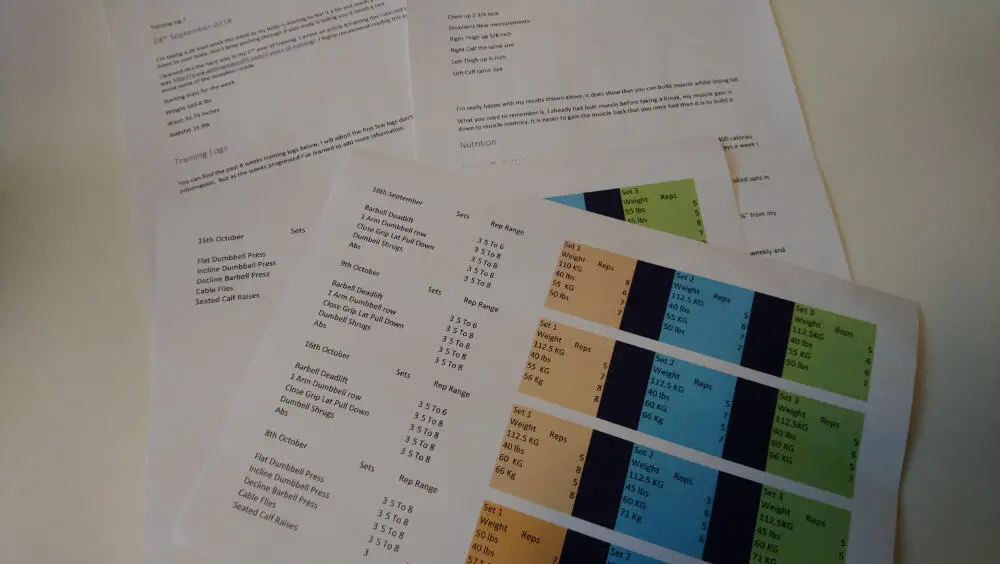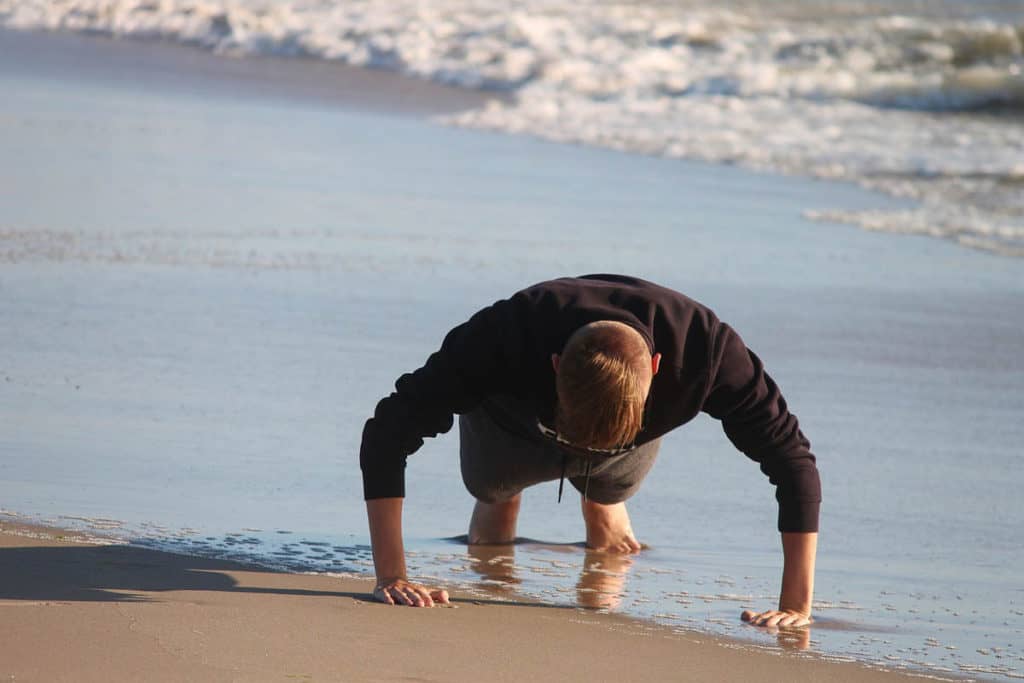There’s nothing complicated about exercise. However, as we get older, we start to shy away from it because we feel like it needs too much effort. Besides, who’s got the time to go to the gym every two or three days?
You’ve just read two huge misconceptions about exercise: it is hard and you have to go to the gym. You don’t. The word exercise is derived from the Latin word excercitare, which means ‘to keep busy.’ All you have to do to exercise is to engage in physical activity. That’s it.
You don’t have to go to the gym either; exercise can be performed anywhere. These days, most people are bound by their busy schedules, train from home, and manage to stay relatively fit while they’re at it.
If people can stay fit using basic fitness equipment at home, how hard can it be? One of the best pieces of training equipment for home use is the dumbbell. It is easy to use, available in various weights, and perfect for low to medium-impact full-body workouts.
Anyone who’s 50 years or older doesn’t need high-impact training unless preparing for a competitive event. Regular low to medium impact training is enough to keep you fit, plus it is less likely to injure your body.
Dumbbell exercises for seniors are tailored to slow down muscle loss and improve cardiovascular fitness. They also have fewer sets and reps, which is ideal because you need to do them consistently to stay fit. It’s not a matter of how much weight you can lift; it’s about doing what you can every day to keep healthy.

Why Use Dumbbells?
Even with the array of portable home gyms and workout tools available, people still resort to dumbbells for their home training. Why is that?
Dumbbells are a piece of unique workout equipment. Nothing is as simple, varied, or versatile as the dumbbell, which can be used to train the entire body, including the legs and core.
The dumbbell set I recommend is the Bowflex Select 552 Adjustable Dumbbells. These dumbells come with a handy storage tray and can be adjusted to the desired weight by simply turning the dial. Check out the latest prices over at Amazon.
Here are four reasons why dumbbells are ideal for everyone:
Dumbbells Are Affordable
Compared to other fitness equipment, dumbbells are incredibly cost-effective. They are widely available in online and retail athletic stores and are often priced based on their weight alone.
You won’t need to spend a fortune to get a decent pair of dumbbells, especially since you’re only looking for a comfortably heavy set that you can gradually get used to. Remember, it shouldn’t be too light either; it should be heavy enough to challenge your muscles the first time you use them.
Dumbbells Are Versatile
With a pair of dumbbells, you can go from upper body strength training to lower body workout to whole-body exercise in a matter of minutes. In addition, dumbbells can be incorporated into nearly all types of activities that require free weights. That’s how versatile dumbbells are.
Apart from being versatile, dumbbells are effective. Dumbells create enough resistance to training major muscle groups through exercises like curls, lunges, and squats.
Dumbbells can also be used singularly or as a pair depending on the requirements of your exercise. That makes them appropriate for a wide range of activities.
Dumbbells Are Portable
Dumbbells are great because you can pack them in your gym bag and have your workout at the beach or park. Their portability is a huge advantage when you need a change of scenery.
Dumbbells Offer Balance
One of the main reasons you should use dumbbells for strength training is this: they are the ideal unilateral training equipment.
Using identical dumbbells ensures that your body strength is balanced. In addition, since each side gets the same amount of resistance, the probability of training one side more than the other is low.
Dumbbells are also good when performing muscle isolation exercises, i.e., exercises that target specific muscle groups.
Dumbbells Come In Different Weight Ranges
Everybody can use dumbbells because they come in many different weight classes. Now, this is important because the weight of your dumbbells can impact your training.
Picking a set that’s too heavy is not recommended for anyone that’s over 50. It’s not a deadlift competition, but you shouldn’t go for a set that you can lift too easily, either.
You’re better off with a moderately heavy set that you can comfortably lift but is heavy enough to tire out your muscles after a few reps. Eventually, your muscles acclimatize to this weight, becoming stronger and leaner.
Dumbbells Are Available As Fixed Or Adjustable Weights
If your only goal is staying fit, a pair of fixed-weight dumbbells is enough to accomplish many exercises. They are especially suitable for cardio and resistance training.
However, if you desire muscle gain, you can opt for adjustable weights, better for increasing muscle mass and adjustability.
Adjustable dumbbells are easy to modify. Just add or remove the discs or plates to adjust the weight, and you’re good to go. When it comes to adjustable dumbbells, you have two choices: those you can adjust manually and those that automatically adjust themselves.
The latter is more convenient to use, although it will cost you more upfront.
Exercise Tips For Seniors
When you hit 40, your body starts to lose lean muscle mass and pack on fatty tissue. I go into muscle loss in my article do you lose muscle mass after 40.
By 50, your endurance levels have gone down, and you become more susceptible to injury and over-exertion.
Related Article: How strong should a 50-year old man be
The truth is, you will not be able to exercise as you used to in your twenties. If you’ve never exercised before, you need to understand that your body may not be as strong as you think it is, so you must take things slow.
Workout Tips For Older Adults
1. Give your muscles about 48 hours to recuperate after a workout. Muscles need time to heal and grow new muscle cells, so you must enforce this 2-day resting period if you want to see results and if you want to avoid getting injured.
2. Pace yourself. You might feel tired very quickly during the first few times, and that’s normal for beginners. Rather than push yourself, take the time to recover after every set and carefully carry out your training. Don’t be bent on performing the exercise quickly; it’s not a sprint; it’s a marathon. Stop if you have to, catch your breath, and then resume your workout. It gets more comfortable with time, so be patient with yourself.
3. Allocate 30 to 45 minutes to each session. That is enough time to thoroughly train any muscle group and train at your own pace.
4. Exercise three times a week. It doesn’t have to be a daily routine, although there’s no harm in conditioning your fitness every day. If it helps, create a schedule and highlight the muscles you intend to train on each day, leaving enough time for them to recover and grow. Why not include some walking and climbing stairs into your training routine.
10 Easy Dumbbell Exercises For seniors
1. Dumbbell Chest Press
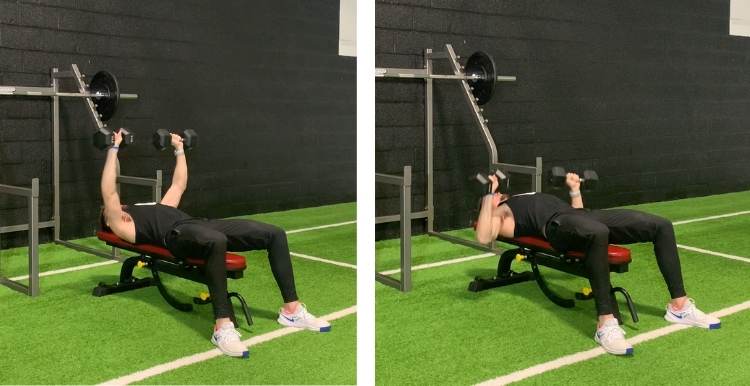
The chest press is a compound exercise that engages the pectoral and triceps.
Lie down flat on a workout bench while holding a dumbbell in each hand. Rest the dumbbells on your thighs, and make sure your feet are flat on the ground.
If you don’t have a bench, you can lay on the floor instead.
Carefully, using your thighs to push up the dumbbells, your arms should be 45° to your upper torso and bend your elbow so that your forearm and upper arm form a 90° angle. The dumbbells should be shoulder-width apart, and your palms should face away from you (towards your feet).
Ensuring that your back is flat against the bench, use your chest to push up the dumbbells until your arms are fully extended. Don’t lock your elbows. Instead, use controlled motion to bring back down the dumbbells slowly. It should take you longer to lower the dumbbells than to raise them.
The chest press can be done on a flat, inclined, or declined bench. The movement is the same for all three exercises. Incline chest presses target the upper pecs while decline chest presses target the lower pecs.
2. Dumbbell Chest Fly
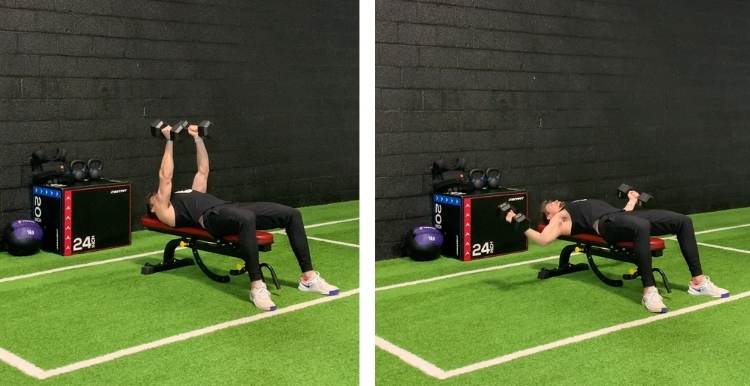
Chest flys target the major pectoral muscle (pectoralis major) and can be performed on the flat, decline, and incline benches.
Lie down on the bench with the dumbbells resting on your thighs like the chest press. If you don’t have a bench, you can lay on the floor instead.
Raise the dumbbells until they’re in front of you shoulder-width apart. Stop just before you lock your elbows and keep your palms facing each other. Your elbows should be slightly bent. This is the starting position.
Slowly lower your arms out in a wide arc until you can feel a strain on your chest muscles. Your body should look like the letter T, and your palms should be facing up. Keep your arms rigid during the arc. It is only your shoulder joints that should move.
Return to the starting position, and repeat as many times as necessary.
3. Dumbbell Curls
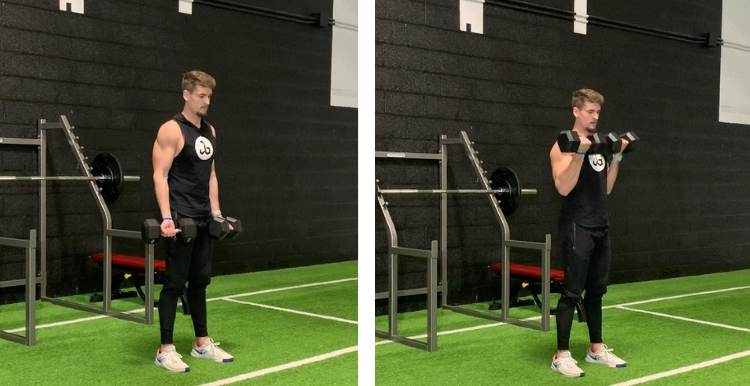
Dumbbell curls can be done in seated or standing positions. When standing, you engage your abdominal core, so a standing dumbbell curl is good for your abs as well. Sitting down doesn’t engage the core as much.
If standing, your starting position will be with your feet placed a few inches apart. Engage your core. That means keeping your abdominal muscles tight. They help with stability and balance.
Bend your knees a little to remove the pressure from your back. With your chest out and your arms along your sides, hold a dumbbell on each side to get into the starting position.
Raise the dumbbells, one at a time, up towards your shoulder. Your elbows should be locked, and your upper arms should be still. During the curl, rotate your wrist until your palms are facing up. At peak curl position, squeeze your bicep. Lower the dumbbell while rotating your wrist so that your palm is facing you, and repeat the curl with the other arm.
If you’re comfortable with it, you can do it with both arms at a time. Most people prefer to focus on one arm at a time, however.
Keep your body still. Don’t swing during the curling movement. Also, don’t do curls on a bench with no back support because you risk bending or arching your back.
The curl has different variations. One of them is the hammer curl. This exercise targets part of the forearm muscles known as the brachioradialis muscles. It uses the same movement as a standard curl. The only difference is that there is no wrist rotation. Your palms keep facing your body from the beginning to the end of the curl.
Like standard curls, you can do these seated or standing, and with one arm or two arms at a time.
Another variation is the concentration curl. This exercise is great for your biceps.
Sit in a chair or a bench while holding one dumbbell. Your arm should be between the legs. Spread out your legs with your knees bent, and keep your feet flat on the floor.
Then place the back of your upper arm against the top of your inner thigh. Your palm should be facing away from you (pointing in the same direction as your feet). Without moving your upper arm, curl the weight while squeezing your bicep. Your upper arm should not be moving. Stop once the dumbbell is at shoulder level, contract your bicep, and slowly lower the weight.
Your elbow should stay in contact with your leg throughout. At the peak of the curl, your fist should be tilted so that your thumb sits lower than your pinkie. Lower the dumbbell as you inhale, and exhale when you raise it.
4. Dumbbell Shoulder Press
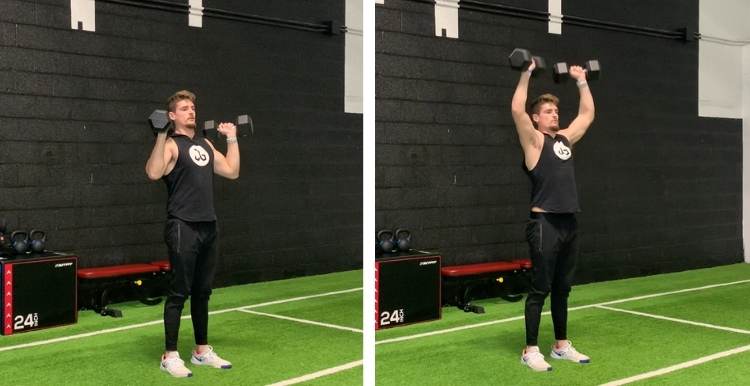
As a compound exercise, the shoulder press targets multiple muscle groups. It focuses on the anterior deltoids and triceps. You can do it standing up or seated. Let’s talk about the seated version.
Using an overhand grip, pick up your dumbbells while sitting on a bench with back support. Raise the dumbbells to your shoulders. Rotate your wrists until your palms face away from you to get in the starting position.
Slowly raise the dumbbells until your arms are fully extended, or the dumbbells touch each other. Your palms should be facing the ceiling. Hold for a brief spell, then lower them down to the starting position. Repeat as many times as necessary.
5. Dumbbell Shoulder Raises
Raises and flys target all three shoulder muscles, anterior, lateral, and posterior deltoid muscles. These muscles can be some of the weakest in the body. The exercise may take anywhere from 3 to 8 minutes.
There are three different types of dumbbell raises to perform.
- Front raises
- Lateral raises
- Reverse flys.
First, there’s the front raise, which targets the anterior deltoid.
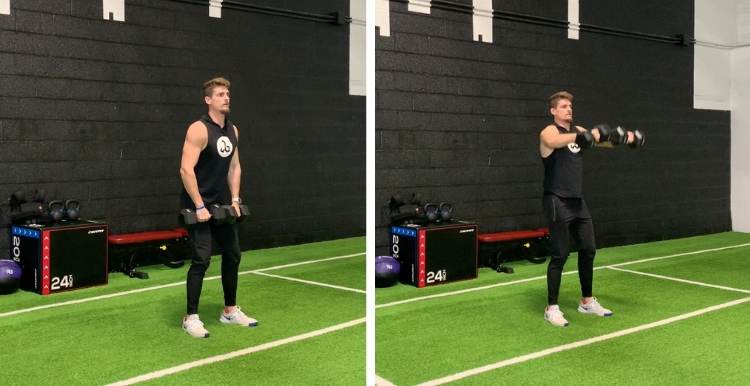
Stand upright with a pair of dumbbells in each hand, make sure that your torso is straight and that the dumbbells are on your thighs with your arms extended. This is the starting position.
Raise the dumbbells to the front while keeping your torso still. Your palms should be facing the floor, and your elbows should be slightly bent. Make sure your arms are parallel to the floor, then hold the contraction for a few moments.
Revert to the starting position and repeat as necessary. You can perform a front raise with both arms or one hand at a time.
The second is the lateral raise.
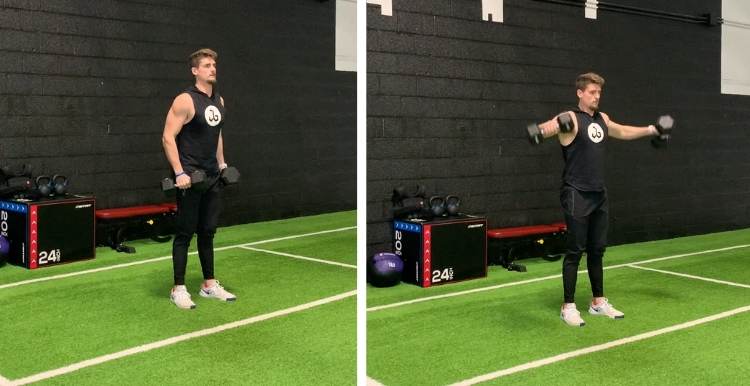
Pick up your dumbbells let them hang by your sides as you stand upright with your core engaged and your head up straight. This is the starting position.
While keeping your torso straight and stationary, raise the dumbbells to your side until your arms are parallel to the floor. Your elbows should be slightly bent, and your arms should be tilted forward a little like you’re serving drinks. Hold the position for a moment while squeezing your muscles.
Slowly lower the dumbbells to the starting position and repeat as necessary.
The third is the reverse fly.
As reverse fly also targets your back muscles, I cover this exercise in more detail in Exercise 6 dumbbell reverse fly
6. Dumbbell Reverse Fly
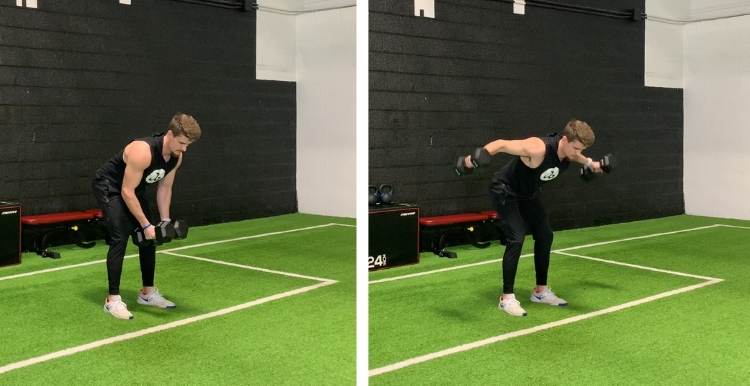
The reverse fly, sometimes known as the back fly, works on the upper back muscles and rear deltoids.
Bend forward at the hips while holding a pair of dumbbells. Your torso should be almost parallel to the floor, and your feet should be shoulder-width apart.
Let your arms dangle the weights down your sides. Your palms should face each other and bend slightly at the elbows.
Ensure that your back stays flat and your torso stationary, raise your arms until they are parallel to the ground. Don’t forcefully stretch your arms; let your elbows remain slightly bent.
Hold the position, then lower the weights and repeat as necessary.
7. Dumbbell Shoulder Shrug
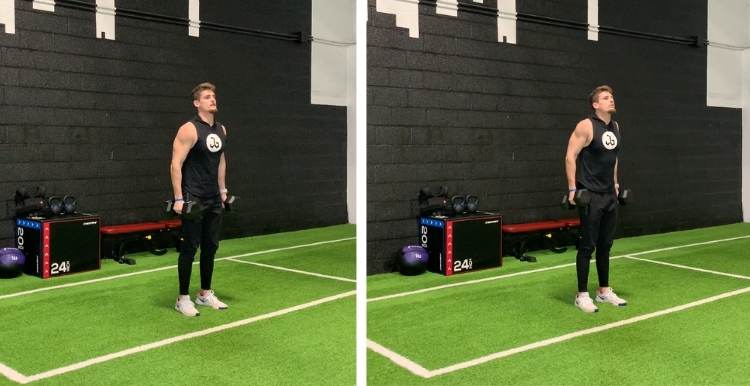
The shoulder shrug is designed to work out your upper traps. This exercise is best done at the end of your routine.
Stand upright with your hands at your sides while holding a dumbbell in each hand. Your palms should face inwards towards your torso. Lift the weights by raising your shoulders as if you’re shrugging. Hold for a second, then lower them back down and repeat.
Remember, keep your arms stationary. Only your shoulders should move. At the peak of the contraction, your shoulders should be lifted and shoulder blades squeezed together.
8. Dumbbell Dead Lift
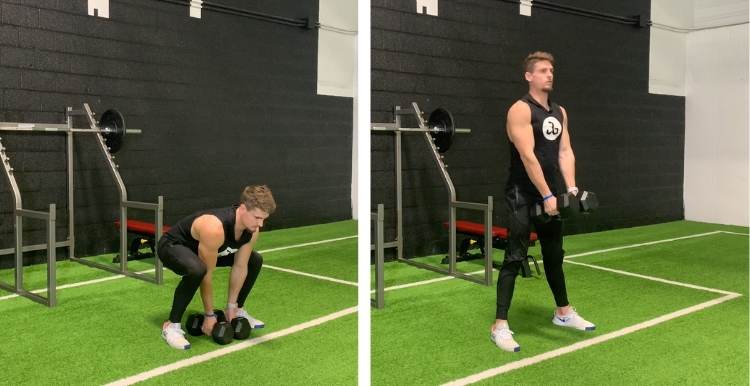
Doing deadlifts using dumbbells is a great way to get your lower back muscles in shape. Deadlifts also target some major muscle groups in the upper body.
With your feet hip-width apart, stand upright with a dumbbell in each hand. Hold them using an overhand grip at arm’s length in front of your body. Let them rest lightly on your thighs.
Make sure that your back is straight, your shoulders pulled back, your knees bent a little, and your head held up high.
Start by bending at the hip to lower your torso until it is nearly parallel to the floor. Pause for two seconds, then slowly revert to the starting position.
This exercise is crucial for building strength and stability and conditioning your lower back to minimize the risk of injury when lifting heavy things.
9. Dumbbell Goblet Squats
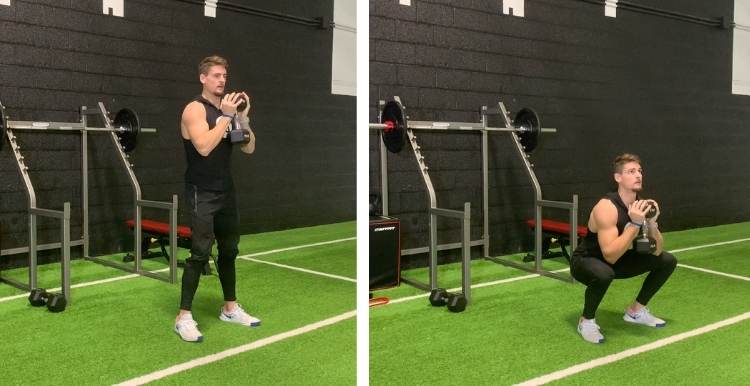
The goblet squat is a gateway exercise to learning how to do free squats. It can also replace barbell squats, where you squat with a barbell balanced on your shoulders.
Select a dumbbell that’s comfortable to lift and hold it vertically with both hands, palms facing up. Your palms should be under the edges of the dumbbell head, and your forearms should cradle the rest of it.
Maintain an upright posture with your chest out, shoulders back, torso straight, and feet shoulder- more width apart. This is the starting point.
Start the squat by slowly descending until your thighs are either parallel to the floor or are lightly grazing your calves. Pause briefly, then return to the starting position and repeat the exercise.
While pushing up, tighten your abdominals and push up through your heels.
10. Dumbbell Front Lunges
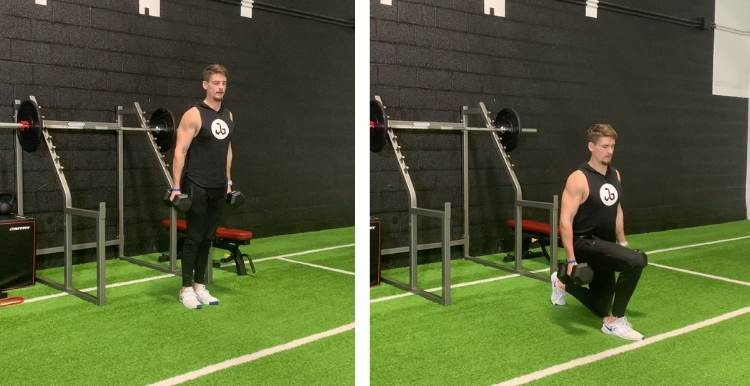
Dumbell lunges allow you to train your leg muscles. They increase muscle mass, improve joint movement, and generally enhance your physical performance.
Take two dumbbells and hold them by your sides with your palms facing inwards. Make sure your torso is straight.
Step forward around two feet away from your starting position. Land on your heel first, then your forefoot. With your torso straight, lower your upper body while maintaining balance until the rear leg is nearly kneeling.
Keep your front shin perpendicular to the ground to avoid placing strain on the joint during the motion.
Once in a full lunge position, hold for a moment, then push back using the heel of your extended foot. Switch legs and repeat the lunges as many times as you need to.
Reps And Sets For Dumbbell Exercises: What You Need To Know
For any exercise to be effective, you have to perform several repetitions. These are called reps. A group of reps is known as a set.
For instance, if you’re doing the dumbbell fly, you may perform them 10 – 15 times, then rest, and repeat for another 10 – 15 times more. So these are two sets of 10 – 15 reps each.
How Many Reps Per Set Should You Do, And How Many Sets Are Appropriate Per Session?
If you’ve never worked out before or have been years since you last exercised, start small and gradually increase your reps. Start with 8 – 12 reps per set and 2 – 3 sets per exercise.
Remember, all you need is 30 – 45 minutes a day to maintain peak body fitness. As your body gradually adapts to the exercise, you will find it easier to get through your sessions.
You can increase your reps to 15 per set and do 3 – 5 sets per exercise when the exercise gets easier. Alternatively, you can maintain the number of reps and sets and instead switch to heavier dumbbells.
The good news is that if you start slow and learn how to perform the exercise correctly, it becomes more comfortable that you start looking forward to your next session. After that, increasing the weight or the number of sets becomes a welcome challenge, and before you know it, your body starts to gain significant muscle mass and strength.
Conclusion
The loss of muscle mass, scientifically known as sarcopenia, can start as early as your 40s and continue well into your 60s and 70s. With a loss in muscle mass, you lose your fitness, and your physical performance dips.
Regular exercise can considerably slow down muscle loss in your advanced years. However, as inevitable, sarcopenia only becomes a problem when the body is left to weaken and deteriorate until movement becomes a problem.
Exercising with dumbbells is convenient. You get all the benefits of exercise using two essential workout equipment. For example, exercise improves cardiovascular health, raises overall energy levels, and prevents musculoskeletal problems like hip dislocations down the line.
Staying fit when you age is far more critical. Exercise can add years to your life. Fortunately, there’s nothing complicated about exercising. All you need are the right tools, such as dumbbells, the right exercises (as listed above), and yourself.
Resources Used In This Article
- Dumbbell Exercises For Men And Women Over 50
- Dumbbell Chest Workout At Home
- Dumbbell Bicep Exercises At Home
- Best Dumbbell Shoulder Workout – To Strengthen And Build Shoulder Muscle Mass
- Build Strong Back Muscles With Just Two Dumbbells
- Top Dumbbell Workout For Legs – Strengthen Quads, Hamstrings And Glutes
- Dumbbell Exercises for Elderly Adults
- The Only 5 Dumbbell Exercises Older Adults Need for Total-Body Strength

